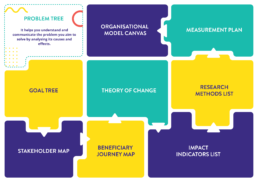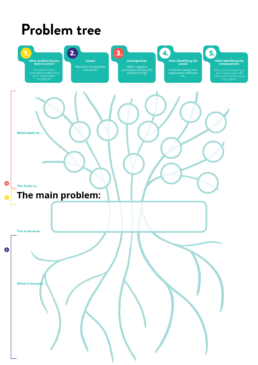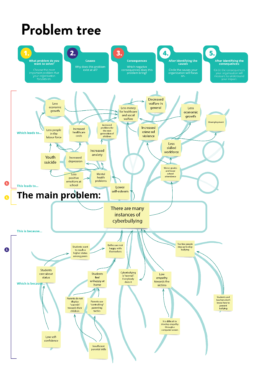Problem Tree

A PROBLEM TREE helps you understand and communicate the problem you aim to solve by analysing its causes and effects.
Solveiga Skaisgirytė (Global Citizens Academy)
For us, the most useful way is to use the problem tree for our team problem analysis so that we can understand the sources of communication, productiveness problems, why we face the recurring conflicts, etc.
But we also find it very useful when analysing the general problems in our community/society that we seek to solve as a social enterprise.
Jānis Broks (SIA “Dzīves oāze”)
The problem tree allows me to better show the situation that will be achieved in the future after my service is done.
It allows me to dig deeper and see several layers of what can happen with/without my intervention. It helps me to justify the price of the service as the tree shows what kind of effect/impact my activities can have.
What is it?
Organisations exist to solve one or multiple problems in the community or society. The problem tree helps you to systematically analyse the causes and effects of the problem(s) that you want to solve as a part of your organisation’s mission.
The easy-to-use tool works best during the design and/or planning process, but also anytime when core problems need to be (re)identified or clarified.
Perhaps you are one of those people who do not like the word “problem”. In that case, feel free to rename it as a tree of challenges, needs or issues. The tool will remain as useful for you as before.
This tool helps you understand a) why the problem exists at all and b) what things happen as a result of the problem. Mapping the causes of the problem may help you understand what you need to do to make the problem disappear. Mapping the consequences of the problem can help you understand what would the positive results be if the problem would be lessened or removed.
First, you have to define the core problem that your mission focuses on.
Below the core problem, write the main causes of the problem and the causes of the main causes etc. until you understand the causes well enough.
Above the core problem, write the main consequences of the problem and the consequences of the main consequences etc. until you understand the consequences well enough.
Watch the video to get an idea of what the tool is about or continue reading after the video player.
In more detail…
1.Start by writing down the core problem that you want to solve.
2.Write down the causes of the problem by asking a series of “why” questions. The deeper you go, the better.
The core problem is P.
Why does P exist?
Answer = A.
And why does A exist?
Answer = B.
And why does B exist?
Answer = C
Etc.
3.Write down the consequences. What does the problem lead to?
The core problem is P.
What does P lead to?
Answer = R.
And what does R lead to?
Answer = S.
Etc.
4.Analyse the problem tree and make choices about your mission and activities.
- Would you like to keep a problem as the central problem you’re focusing on, or would it be more inspiring/realistic to tackle any of the causes/consequences as your main mission?
- What causes/consequences can you tackle yourself? What would be the partnerships that you would need to remove more causes or consequences of the problem?
You can also have variations in its use
Variations in certainty.
LIGHT: Write down the keywords based on your (team’s) experience, opinions and gut instinct.
MEDIUM: Involve other organisations, ask for expert opinions, including the viewpoints of the stakeholders that have different experiences and values compared with your team.
ADVANCED: Only include causes and consequences that the scientific research and literature has shown to have clear links to the main problem.
Why to use it?
☑ To understand better the problem(s) your mission aims to solve (or to find out what your mission should be).
☑ To make informed decisions about which aspects of the problem you can and want to concentrate on.
☑ To better explain and communicate the problem and its causes/effects to the stakeholders whom you need to convince. You can show the tree or just use it to prepare your arguments for presentations or negotiations.
When to use it?
☑ When developing or updating your mission and vision or specifying your strategic choices.
☑ When the organisation aims to understand and communicate certain topics/problems better.
☑ When you want to change or expand your activities to tackle more causes.
☑ When looking for cooperation partners (to collaborate with organisations that address the causes and/or consequences of the problem that you cannot or don’t want to address with your own organisation).













